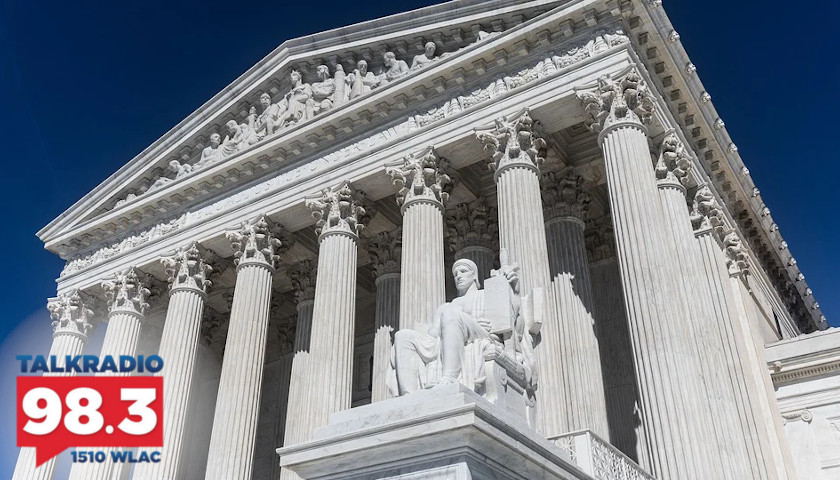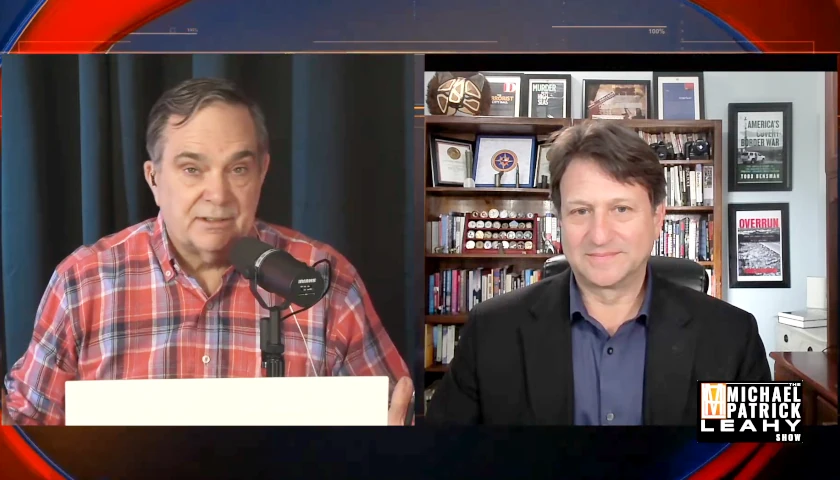Live from Music Row Tuesday morning on The Tennessee Star Report with Michael Patrick Leahy – broadcast on Nashville’s Talk Radio 98.3 and 1510 WLAC weekdays from 5:00 a.m. to 8:00 a.m. – host Leahy welcomed Tim Pagliara CIO of Cap Wealth Management to the studio to discuss the Supreme Court case that will address violations of the Administrative Procedures Act and the two issues of constitutionality and whether it will go back to the trial court for damages that shareholders are entitled to.
Leahy: Our guest is Tim Pagliara, author of Another Big Lie: How the Government Stole Billions From The American Dream of Homeownership and Got Caught. By the way, Tim, thanks so much for coming down to our Studios on Music Row. It’s kind of fun, isn’t it?
Pagliara: It’s a blast.
Leahy: I know you love radio, t0o. Everybody loves the radio.
Pagliara: I got a face for radio.
Leahy: So do I. I mean, you know, I get here at 5:05 a.m. in the morning. I don’t look, you know, not ready for prime-time cameras. I’ll tell you that for sure. So we’re talking about this case. Your book fantastic book – doing very well. It’s on Amazon and is number one in banking and finance right now.
Pagliara: Yes.
Leahy: And by the way, go get the book right now at Amazon.com. Just check out Another Big Lie. You’ll be able to order it and have it in your house in a day or two.
So what I find interesting about this: September 2008 is when the government, George W. Bush made the bad decision, as you said, to place Freddie Mac and Fannie Mae the mortgage purchasing institutes of qualified governmental institutes into conservancy. Then in 2013, ’14, the Feds say, ‘Let’s keep it in the conservancy,’ and misrepresented really how well those organizations were doing.
Pagliara: Yes.
Leahy: The lawsuit doesn’t get filed until 2015 because the people that had their money basically taken away the investors.
Pagliara: Actually, the first lawsuit was filed in June of 2013, the Collins case.
Leahy: So there was a whole bunch of cases. Now, how much money do the plaintiffs, how much have they had to spend to get this case up to the Supreme Court? And how long is it? What’s the path been?
Pagliara: If you take all of the lawsuits collectively, my estimate is those plaintiffs have spent almost 100 million dollars.
Leahy: And just in legal fees.
Pagliara: Just in legal fees.
Leahy: How much of their money has been taken by the federal government, would you guess?
Pagliara: $350 billion?
Leahy: $350 billion?
Pagliara: Yes.
Leahy: Wow.
Pagliara: Big numbers.
Leahy: And going to, I don’t know, fund Obamacare? Things like that”
Pagliara: That’s one of the places that the money went. Treasury Secretary Mnuchin on Maria Bartiromo show admitted that. He wouldn’t pinpoint exactly where the money was spent. But it went for a variety of non-budget, appropriated purposes.
Leahy: Wherever they wanted to just have their little…fund not known to the public go.
Pagliara: That’s right. Exactly. And they were battling Grover Norquist. They were battling the constraints of the Budget Control Act, and they acted in their best interest in violation of the property rights of shareholders. This is a big case. They can take the assets of Fannie Mae and Freddie Mac. You can imagine what Elizabeth Warren can concoct with wealth taxes and just taxing individuals.
Leahy: That’s all in the works right now. These are the kinds of things that they’re contemplating, right?
Pagliara: Yes.
Leahy: So in this particular case, Collins versus Yellen. And Yellen versus Collins.
Pagliara: This case came to the United States Supreme Court after an en banc hearing in the Fifth Circuit.
Leahy: So the first step is to go to a district court.
Pagliara: That’s right.
Leahy: Then it goes to the Fifth Circuit court.
Pagliara: It went to the Court of Appeals. So the plaintiff lost at the district court level. They went to the court of appeals, and it was a split decision. The plaintiffs appealed to the entire circuit in an en banc hearing.
Leahy: So the way it works is in the Fifth Circuit, they would assign what, three judges to look at it?
Pagliara: Yes.
Leahy: And they lost there.
Pagliara: It was a mixed decision. So there was enough confusion between the three judges.
Leahy: So the Fifth Circuit, we have 11 circuits courts of appeal in the country, of course, the worst being the ninth out in California, where they’re all a bunch of lefties. It’s getting better. Tell us a little bit about the Fifth Circuit Court of Appeals here in our federal court system. Pretty good reputation?
Pagliara: Excellent reputation. They addressed civil rights in the 60s. They’ve had a reputation for taking on tough issues, being leaders, and thinking outside the box. And they decided to take this on in an En banc hearing.
Leahy: Now Let’s just stop and explain what an en banc hearing is for the Circuit Court of Appeals. What is that?
Pagliara: That’s when you take all of the justices and the different circuits, and they all come together collectively as a group, and they will hear additional arguments following a court hearing.
Leahy: So an en banc hearing of the Fifth Circuit would include 20 judges or something like that?
Pagliara: 16.
Leahy: 16 judges. And the Fifth Circuit covers Texas…
Pagliara: Parts of Louisiana.
Leahy: So here we go. There’s a sort of a split decision when the three-judge panel first reviews in the Fifth Circuit Court of Appeals, it goes en banc to all 16. What happens there?
Pagliara: Well, there are two issues before the court. One was whether or not the federal housing finance administrator, which was overseeing the conservatorship of Fannie Mae and Freddie Mac whether he was appointed constitutionally. Whether it was a constitutional appointment. And the Consumer Finance Protection Board case, which occurred earlier. The court found that that was unconstitutional.
Leahy: And by the way, it’s just for our listeners, the Consumer Financial Protection Board.
Pagliara: That’s a mouthful.
Leahy: It really was unconstitutional when passed in the Dodd-Frank Bill 2010 – the brainchild of wait for it – our favorite Native American Senator, Elizabeth Warren. That’s her brainchild. And so that key element of that particular law was found unconstitutional.
Pagliara: And so they did the same thing. The director of the Federal Housing Finance Administration, which was overseeing the conservatorship, was appointed in exactly the same way as the CFPB.
Leahy: Got it.
Pagliara: And this is where you get into that fourth branch of government. The issue there was they wanted to create an agency that the executive branch of government couldn’t remove the director. That’s what they did with the CFPB. That’s what they did with FHFA. And in the CFPB, the court ruled that that was unconstitutional. It had to be removable.
Pagliara: That’s right.
Leahy: And that’s why when Biden got elected, they got a new head of the CFPB.
Pagliara: So with the Fifth Circuit, the first issue is constitutionality. The Fifth Circuit already ruled that it was unconstitutional. They were split on the remedy. The issue before the Supreme Court is whether or not the plaintiffs are entitled to prospective or retroactive relief. If retroactive relief…
Leahy: It’s a lot of money.
Pagliara: It’s a lot of money.
Leahy: It’s like $350 billion.
Pagliara: Most legal scholars don’t believe that the plaintiffs, the shareholders, will get retroactive relief. They’ll get prospective relief and the President will be able to remove the Director immediately at will. It will be an at-will appointment like any other cabinet appointment.
Leahy: Too bad this case wasn’t decided before January of 2021, I think.
Pagliara: Well, President Trump honored the rule of law, and he waited for this to happen. And so he actually did a very good job with that. Now, the second issue before the court is called the Administrative Procedures Act [APA].
Leahy: 1950 act that sort of was the beginning of the decline of the legislative branch here in America because it’s been abused so much by the rulemaking procedures of various departments, cabinets, and agencies.
Pagliara: And so the violation of the APA, this is the governor that regulates the 10,000-pound gorilla being the federal government. the federal government tends to crush everybody that they get into litigation with. In fact, you can’t even get an injunction against it.
Leahy: So if the Department of Justice decided to go after somebody, for whatever reason, just even if you were totally innocent of any of these charges or claims, your legal fees would be, what? A half a million bucks, at least a million to defend?
Pagliara: Millions.
Leahy: Not exactly a fair deal.
Pagliara: It’s not a fair deal. So the court ruled that the government violated the APA, violated the very statute that they’re supposed to enforce that has been remanded to the trial court.
Leahy: Sent back.
Pagliara: And so the Supreme Court intervened, and they’re going to weigh in on this. So they got the two issues. They got constitutionality, and they have the whole issue of whether this goes back to the trial court for damages that the shareholders are entitled to.
Leahy: This will be fascinating to follow when we get back. I know you’re not in the land of being a predictor, but we’ll want to look at a couple of the possibilities that will come down in this very interesting Supreme Court decision.
Listen to the full third hour here:
Tune in weekdays from 5:00 – 8:00 a.m. to the Tennessee Star Report with Michael Patrick Leahy on Talk Radio 98.3 FM WLAC 1510. Listen online at iHeart Radio.




